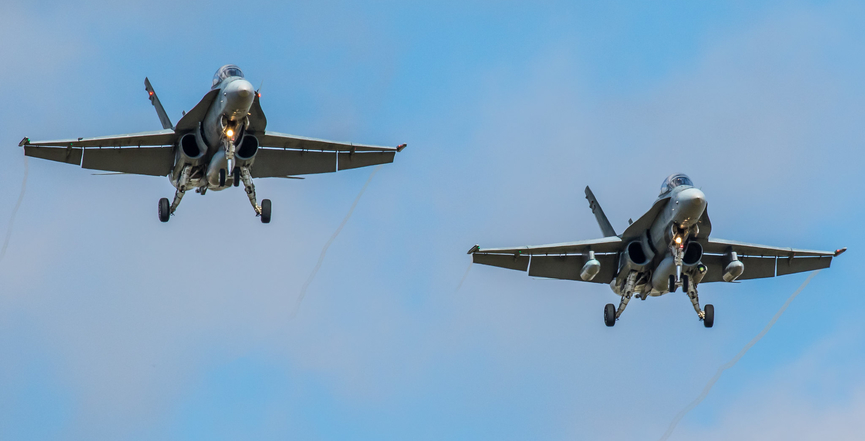Canada’s current fleet of CF-18s cost $4 billion to purchase in 1982, $2.6 billion to upgrade in 2010, and $3.8 billion was budgeted in January 2020 to extend their lifespan. That adds up to at least $10 billion for these fighter jets with billions more likely spent over the past decades on fuel and maintenance costs.
As the Canadian government now prepares to spend $1 billion on Raytheon missiles and related equipment for these CF-18s and accept bids for a $19 billion contract for new fighter jets this coming July 31, it’s timely to ask if the billions Canada has spent on fighter jets have helped to avert war/bring peace.
Here’s a brief overview of the 1,598 bombing missions Canadian CF-18s have conducted over the past 30 years:
Gulf War/Iraq — 56 bombing missions
The CBC reports: “In 1991, the Canadian Forces deployed 24 CF-18s to aid the U.S. in Operation Desert Storm and Desert Shield during the first Gulf War. These aircraft were based out of Qatar and flew over 5,700 hours, participating in 56 bombing missions.”
Joshua Holland has critically written: “The first Gulf War was sold on a mountain of war propaganda. It took a campaign worthy of George Orwell to convince Americans that our erstwhile ally Saddam Hussein — whom the US had aided in his war with Iran as late as 1988 — had become an irrational monster by 1990.”
Yugoslavia — 558 bombing missions
The CBC has reported: “In June 1999, 18 CF-18s began participating in NATO air strikes against Serbian forces, conducting 10 per cent of all strikes, including 558 bombing missions.”
Jaume Castan Pinos has written:
“The 78-day campaign, known as Operation Allied Force, was officially conducted to protect civilians [but] between 80% and 87.5% of the victims of the Kosovo conflict died during or in the aftermath of Operation Allied Force. The KLA took advantage of the power vacuum created by the NATO intervention to carry out revenge killings and abductions against Serbs, Bosniaks, Roma and other minorities.”
His assessment of this intervention concludes: “Decades on, it’s clear that reaching a political settlement after a military intervention can be a nightmare. Certainly much more difficult than launching a bombing campaign.”
Libya — 733 bombing missions
The National Post has reported: “The six CF-18s — backed up by one spare — have logged 733 bombing sorties above the North African nation, while the Canadian re-fuelling and reconnaissance aircraft have added hundreds more flights.”
The Canadian Press adds: “They eventually flew 10 per cent of all NATO strike missions.”
Bianca Mugyenyi of the Canadian Foreign Policy Institute has written:
“In 2011, a Canadian general led the bombing of Libya, which the African Union vigorously opposed. AU officials argued the NATO war would destabilize that country and the region. An upsurge in anti-Blackness, including slave markets, subsequently appeared in Libya and violence quickly spilled southward to Mali and across much of the Sahel.”
Iraq — 246 bombing missions
In October 2014, the Ottawa Citizen reported: “As the Conservative government contemplates sending CF-18 fighter jets into Iraq, Canadian pilots may soon be bombing some of the same gunmen their actions supported several years ago elsewhere.”
That article adds: “The Islamic State of Iraq and the Levant, or ISIL, which has seized parts of Syria and Iraq, includes a large number of volunteers from Libya who fought in the 2011 uprising that overthrew dictator Col. Moammar Gadhafi.”
By July 2016, The Guardian reported: “Allegations that the [illegal] invasion of Iraq [in 2003] increased the terrorist threat to the UK and helped spawn the terror group Islamic State are supported by intelligence documents released as part of the Chilcot report.” In other words, one war helped to create the conditions for another war.
Syria — five bombing missions
By April 2015, the BBC reported: “Canada has carried out its first air strikes in Syria, as part of the US-led coalition fighting Islamic State militants.”
Prior to the start of that bombing, the CBC reported: “The move has raised difficult questions about whether the operation would violate international law. Similarly, it would mean Canada is joining a very small group of nations pushing the boundaries of international law in the name of self defence, say legal experts.”
On March 11 of this year, UN Secretary General Antonio Guterres tweeted: “The conflict in Syria is entering its tenth year. A decade of fighting has brought nothing but ruin and misery. And civilians are paying the gravest price. There is no military solution. Now it is the time to give diplomacy a chance to work.”
It should also be emphasized that CF-18 bombing missions have resulted in civilian casualties. The Globe and Mail has reported that this could include up to 40 civilians in Iraq, while CBC has reported “Off-target airstrikes in Iraq buried behind wall of secrecy.”
With the Canadian government now prepared to spend billions more on fighter jets and missiles, this is a critical moment to discuss alternatives to war and to mobilize around the need for peace-building.
Brent Patterson is the executive director of Peace Brigades International-Canada. This article originally appeared on the PBI-Canada website. Follow @CBrentPatterson @PBIcanada on Twitter.
Image: aezoss/Flickr



